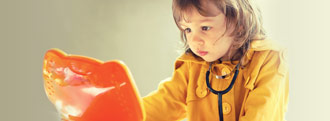Our Health Library information does not replace the advice of a doctor. Please be advised that this information is made available to assist our patients to learn more about their health. Our providers may not see and/or treat all topics found herein.
Bunions
Condition Basics
What is a bunion?
A bunion is an enlargement of bone or tissue around the joint at the base of the big toe. The big toe may turn toward the second toe. The tissues around the joint may be swollen and tender.
A bony bump at the base of the little toe is called a bunionette or tailor's bunion. The little toe also bends inward, and the joint swells or enlarges.
What causes a bunion?
You may get bunions if:
- The way your foot is shaped puts too much pressure on your big toe joint. Because bunions can run in families, some experts believe that the inherited shape of the foot makes some people more likely to get them.
- Your foot rolls inward too much when you walk. A moderate amount of inward roll, or pronation, is normal. But damage can happen with too much pronation.
- You have flat feet.
- You often wear shoes that squeeze the toes together or that shift weight to the toes (such as high-heeled shoes).
All of these may put pressure on the big toe joint. Over time, the pressure forces the big toe out of alignment, bending it toward the other toes.
What are the symptoms?
Your bunion may not cause any symptoms. Or you may have pain in your big toe, red or irritated skin over the bunion, and swelling at the base of the big toe. The big toe may point toward the other toes and cause problems in other toes.
How is a bunion diagnosed?
Your doctor will ask questions such as: When did the bunions start? What activities or shoes make your bunions worse? Do any other joints hurt? The doctor will examine your toe and joint and check their range of motion. X-rays, blood tests, and other tests are also sometimes used.
How is it treated?
Bunions are treated to help with pain and walking. Treatment starts with wearing shoes that are wide enough. It may include pads or splints to take pressure off the toe. Applying ice and taking some over-the-counter medicines can also help. Surgery is an option only if home treatment doesn't help.
How can you prevent bunions?
Proper footwear may prevent bunions. Wear roomy shoes that have wide and deep toe boxes (the area around the toes). The shoes should have low or flat heels and good arch supports. Avoid tight, narrow, or high-heeled shoes that put pressure on the big toe joint. Medicine won't prevent bunions.
Health Tools
Health Tools help you make wise health decisions or take action to improve your health.
Symptoms
Your bunion may not cause any symptoms. If you do have symptoms, they may include:
- Pain in your big toe.
- Red or irritated skin over the bunion.
- Swelling or enlargement of the metatarsophalangeal joint at the base of the big toe.
- Displacement of the big toe, so that it points toward the other toes and causes problems in other toes, such as hammer toe.
- Joint pain or stiffness.
A bunionette can cause similar symptoms at the base of the little toe.
Bunions and their symptoms develop slowly over time.
When to Call a Doctor
Call your doctor now or seek immediate medical care if:
- You have severe pain.
- Your toe is cool or pale or changes color.
- You have tingling, weakness, or numbness in the toe.
Watch closely for changes in your health, and be sure to contact your doctor if:
- Pain and swelling get worse.
- You do not get better as expected.
Treatment Overview
Bunions are treated to ease pain and help with walking and other daily activities. Most bunions can be treated at home.
Home treatment includes wearing shoes that have wide and deep toe boxes (the area that surrounds the toes). The shoes should have low or flat heels and good arch supports. You can wear pads or splints to cushion the bunion and take pressure off the toe.
Applying ice and taking over-the-counter medicine can help relieve toe pain.
Avoid activities that put pressure on your big toe and foot. Try activities that don't put a lot of pressure on your foot, such as swimming or biking.
If you have a bunion but don't have pain or discomfort, treatment may not be needed.
Surgery is an option only if other treatments don't help. Bunion surgery is done to help restore normal alignment to the toe joint.
Self-Care
Home treatment can help relieve toe pain and may prevent a bunion from getting worse. Try the following ways to relieve toe pain.
- Use nonprescription pain relief medicine.
Examples include acetaminophen (such as Tylenol) and nonsteroidal anti-inflammatory drugs (NSAIDs) (such as ibuprofen or aspirin). Talk to your doctor about which pain reliever is best for you.
- Try ice and elevation.
Apply ice to the joint for 10 to 20 minutes at a time. Put a thin cloth between the ice and your skin. Elevate your foot so that your toe is higher than your heart.
- Try bunion pads, arch supports, or custom-made supports (orthotics).
Place these just behind the big toe joint on the bottom of your foot. This redistributes your weight while you are walking and takes pressure off your big toe. Ask your doctor to help you choose the right kind of pads.
- Put moleskin or felt patches over or around pressure areas.
These help protect the bunion from being rubbed by your shoes.
- Stretch the parts of your shoes that rub on painful areas.
Look for a shoe repair shop or cobbler that stretches shoes, or ask your doctor to recommend one.
- Buy special or custom shoes for people with foot problems.
You may need to search for a shoe manufacturer who makes these shoes.
Explore more
Surgery
Bunion surgery involves making a cut (incision) in the top or side of the big toe joint area. Then soft tissue and bone are removed or realigned. You may consider surgery if your bunion causes lasting, severe pain that limits your daily activities. You may also consider it if you have a severe foot deformity.
The goals of surgery are to:
- Relieve pain and restore normal alignment to the toe joint.
- Restore normal weight-bearing distribution to the foot.
- Allow you to return to normal activities.
Surgery isn't recommended if you:
- Haven't tried nonsurgical treatment.
- Have health problems that make surgery dangerous. These include diabetes, neuromuscular disorders, and some circulation problems.
- Have unrealistic expectations about the results of surgery (such as being able to wear any kind of shoe).
Bunions may come back after surgery. This is more likely if you keep wearing narrow or high-heeled shoes.
Explore more
Related Information
Credits
Current as of: July 24, 2025
Author: Ignite Healthwise, LLC Staff
Clinical Review Board
All Ignite Healthwise, LLC education is reviewed by a team that includes physicians, nurses, advanced practitioners, registered dieticians, and other healthcare professionals.
Current as of: July 24, 2025
Author: Ignite Healthwise, LLC Staff
Clinical Review Board
All Ignite Healthwise, LLC education is reviewed by a team that includes physicians, nurses, advanced practitioners, registered dieticians, and other healthcare professionals.
This information does not replace the advice of a doctor. Ignite Healthwise, LLC disclaims any warranty or liability for your use of this information. Your use of this information means that you agree to the Terms of Use and Privacy Policy. Learn how we develop our content.
To learn more about Ignite Healthwise, LLC, visit webmdignite.com.
© 2024-2025 Ignite Healthwise, LLC.








